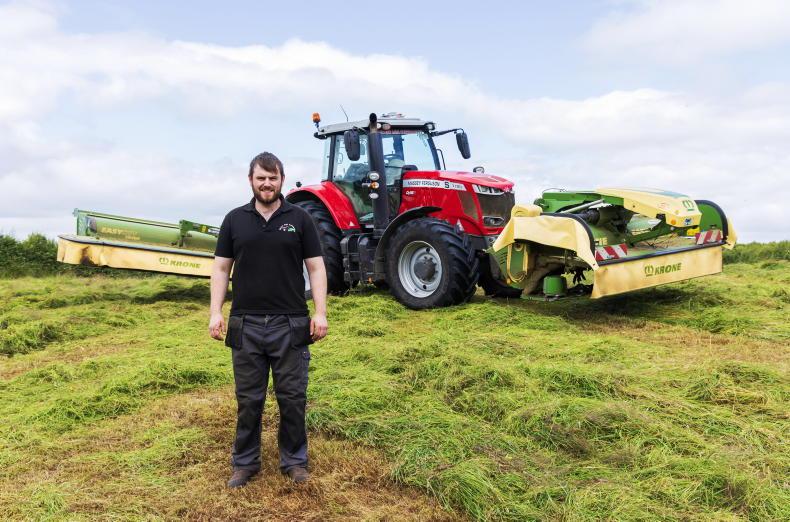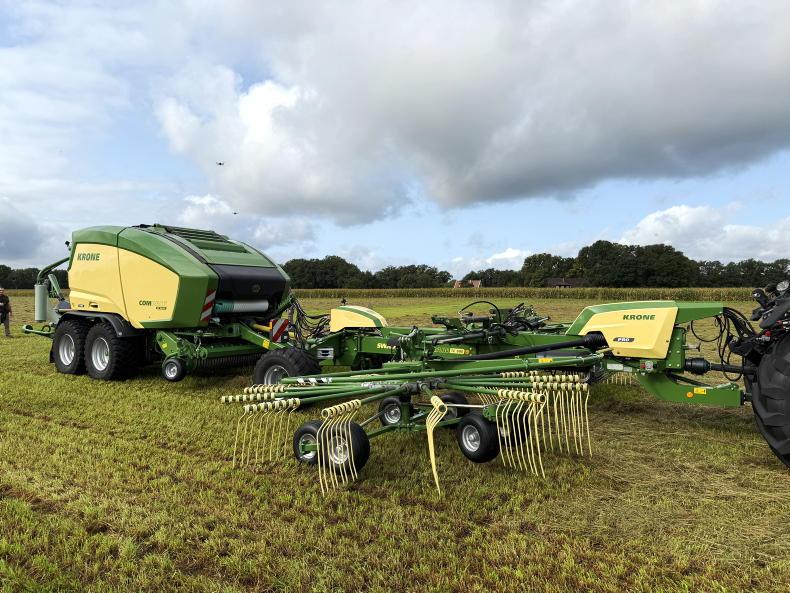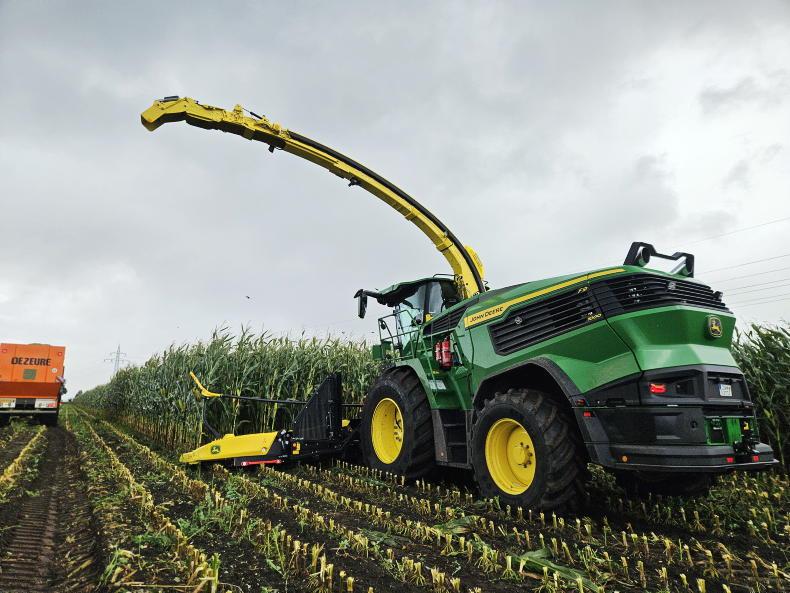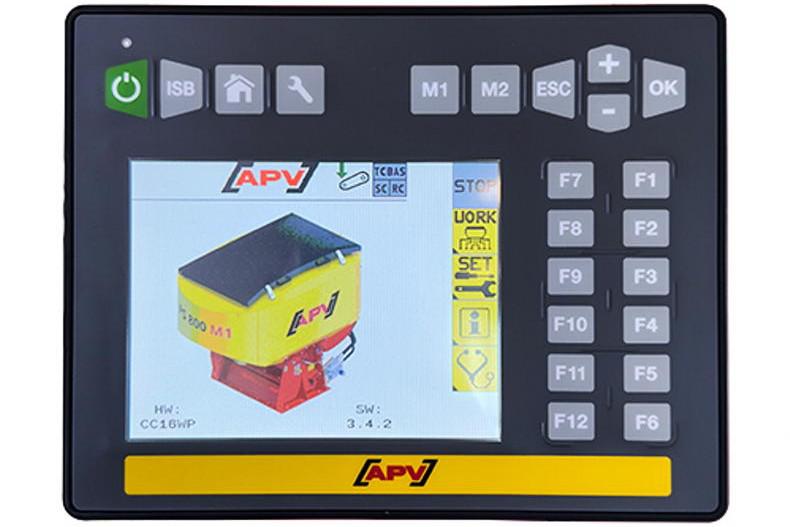Since starting out contracting from scratch in 1996 at the age of 16, Lloyd Forbes has worked hard to build an extensive agricultural contracting business with the help of his wife, Suzanne. Alongside contract work, the duo are also farming and are making the transition from sucklers to dairy.
Based in Carrigaline, Co Cork, the team offers a wide range of services to a customer base within a radius of 15km to 20km.
Their work includes pit silage, round baling, slurry handling, hedge-cutting, fertiliser, as well as tillage operations including ploughing, sowing cereals and maize planting.
Chaser background
Round baling since 2009, the Forbes now run two McHale Fusion 3 balers, one of which is being upgraded to a Fusion 4 for the coming season.
As part of the service, almost all bales are transported and stacked. In order to carry this task, a bale chaser has been the machine of choice instead of the more traditional bale trailer and loader method.
“We started out with a secondhand Keltec eight-bale chaser. It was one of the first chasers in area. We quickly came to the conclusion that it was the best concept for transporting bales. But, since it was only a single axle, it seemed hard on the tractor,” Lloyd explained.

Suzanne McCarthy and Lloyd Forbes, Carrigaline, Co Cork.
With the baling campaign getting busier as the years passed, it was agreed that a higher-capacity chaser was needed. Having weighed up the different chaser options on the market at the time, the Wilson Engineering Super Move stood out.

The Forbes have been running bale chasers since they started baling in 2009.
“I came across the Wilson Super Move at the National Ploughing Championships in 2015. Although new to the market, its design and build quality was impressive. Our local dealer, Trevor Ryall had took on the agency for Wilson so we bought a Super Move 10 machine for 2016,” said Lloyd. Being an early adopter, Forbes’ machine was one of the first 10 units built by Wilson.
Super Move 10
Although a basic machine by today’s terms, the first Super Move 10 worked for four trouble-free seasons, shifting almost 25,000 bales annually.
In 2021, the chaser was replaced for the current Super Move 10, not because it needed replaced but because Lloyd tries to operate a four-year replacement policy when it comes to grass-related machinery.
The only difference with the second machine was that it was equipped with a sprung drawbar and upgraded lighting package.
Given the quantity of bales shifted annually, both Lloyd and Suzanne regard the chaser as an integral part of the baling business.

Four sets of hydraulic rams raise and lower the left and right cages independently.
“On our best ever day, we moved 700 bales but in fairness it was a long day. With a good operator on the machine and a reasonable draw, we would normally shift around 500 bales daily, peak season.
“If it’s a long draw, let’s say over 5km, then we sub in a local guy with his Wilson chaser to help out.
“We have little to no experience with bale trailers, thankfully. The initial thought of needing a loader in the field or a tractor with a front loader and the added time for loading/unloading and strapping down bales was just going to be too slow and costly from a machinery and labour point of view.
“I don’t believe that there is any faster way of transporting bales than a chaser out there.

Four sets of hydraulic rams raise and lower the left and right cages independently.
“Chasers are a machine you’d expect to show signs of wear or fatigue after a number of busy seasons given the stress and strain they are subject to. But, the running costs of both chasers so far has been minimal. I don’t think we’ve ever had a major breakdown, thankfully,” Lloyd said.
The Super Move 10 is offered as standard on a tandem axle for the Irish market.
It is equipped with a mechanical bogey setup, high-speed HO’S axles and air over hydraulic load-sensing brakes (420mm x 180mm brake shoes).
The unit also comes standard on 550/45 R22.5 tyres.
Weighing in at 6,500kg empty and rated for a total weight of 16,500kg, the Forbes work the chaser with a John Deere 6155M, which they feel is more than adequate.
Controls are straightforward.
There are two double-acting spools for the independent raising and lowering of the left and right bale cages.

Forbes' new machine has been ordered with hydraulic opening bale cages.
Four sets of hydraulic rams are used to raise and lower the cages. Once loaded, each cage is locked in place with two hydraulically operated catches; a simple but effective system that will remain locked even if a hydraulic hose happened to fail, Lloyd pointed out.
“The fit and finish of both chasers has been top-class and reflected in their service over the years. They’re steady and pull well on the road, which is important given the length of time spent on it.”
Last year, Lloyd decided to trade and upgrade again for the 2024 silage season. But, this time around, the decision was made to opt for a Monster Move 12, 12 bale model.
Not only is this machine capable of carrying two more bales but, Lloyd decided to have it equipped with the optional hydraulic opening cages. Not only will the addition of hydraulic cages allow for an added degree of forgiveness when loading bales but they will also allow for unloading in more restricted spaces.
Instead of lowering the cages and driving forward, the cages can be lowered, opened and raised while static.
The machine is also equipped with a steering drawbar option and a rear steering axle.
The addition of a steering axle sees the mechanical bogey replaced with a sprung bogey.

The Super Move 10 is equipped with load-sensing air over hydraulic brakes.
The move towards hydraulic opening cages brings with it load-sensing hydraulics and joystick control.
This means that all machine-related hydraulic functions, including the rear steering axle and work lights will be operated via the joystick. The new machine will also be equipped with a slightly wider 560/45 R22.5 tyre.

One of the only differences between Forbes' current Super Move and previous model is the addition of a sprung drawbar.
Lloyd explained: “This time around, we decided to go that bit bigger in size in order to increase output. If we can transport two more bales every load, then that is 20% extra.
“Over the course of a long day where we could move 500 bales, this should become 600 bales at a relatively similar running cost. The bottom line is that it will mean more bales moved daily or an earlier quitting time.
“Manoeuvrability should be no different. I’m confident that with the steering axle, the new machine at 24ft long will go everywhere the 22ft 10 bale machines went. The steering axle should reduce scrubbing and improve tyre wear too.”
Lloyd and Suzanne are one of the few contractors who have been running bale chasers since the start. They view it as the most efficient way of transporting bales for stacking.
Lloyd said: “Today, 99% of the bales we make are chased and stacked. We stack with a JCB TM320S.
“The move to a 12-bale machine should be a good one. However, the chaser does require a good operator, otherwise, there could be a lot of harm done in a short time space. We are lucky in that respect. Otherwise, I would have been more hesitant on going for a bigger, more complicated machine this time around.
“After eight years combined running Wilsons we wouldn’t look back. The strength, performance and finish of the machines really has been second to none,” Lloyd concluded.
Chasers in Ireland
It’s fair to say that the popularity of bale chasers in Ireland has grown in the last 10 years or so. Not only has it been adopted by contractors in parts of the country that have traditionally undertaken the full job from mowing to stacking, but many contractors have expanded their business by offering the service.
While the cage-type designs offered by Wilson Engineering and Keltec are the most popular, we’ve seen two other manufacturers, Malone and Samco, showcase their unique designs in recent years. The major selling points of chasers is the fact they are a one-person operation and eliminate the need for straps as bales are retained during transport.

The Super Move 10 is fitted with 550/ 45 R22.5 tyres.
On the downside, a new chaser will cost the price of almost two fully equipped bale trailers and will join the fleet of seasonal forage equipment parked up for the winter. However, the chaser generally wins when it comes to time and running costs during the season.
Located in Crettyard, Co Laois, Wilson Engineering is owned and run by Adam Wilson. Today, the firm specialises in bale chasers, bale handlers and bespoke low-loaders for the agricultural and construction industries.
Wilson first entered the market with its Super Move bale chaser in 2014 at the National Ploughing Championships. The chaser range was first made up of Super Move 6, 8 and 10 models, capable of transporting six, eight and 10 bales. In recent years, the range has expanded to now include the Monster Move 12, 14 and 16 bale chasers, the latter more suited for export markets.
In total, the firm claims to have in excess of 300 units now working across Ireland, not to mention export markets. The entire design and fabrication process with the exception of the steel-rolling process for the cages is carried out in house.
Likes
Build quality.Ability to move bales fast.Dislikes
Although grease points are grouped, an auto greaser would help reduce routine maintenance.Model: Super Move 10 (current machine).Axle: high-speed bogey axle. Brakes: load-sensing air over hydraulic.Unladen weight: 6,500kg. Max laden weight: 16,500kg.Tyres: 550/45 R22.5.Starting price: €32,500 plus VAT.
Since starting out contracting from scratch in 1996 at the age of 16, Lloyd Forbes has worked hard to build an extensive agricultural contracting business with the help of his wife, Suzanne. Alongside contract work, the duo are also farming and are making the transition from sucklers to dairy.
Based in Carrigaline, Co Cork, the team offers a wide range of services to a customer base within a radius of 15km to 20km.
Their work includes pit silage, round baling, slurry handling, hedge-cutting, fertiliser, as well as tillage operations including ploughing, sowing cereals and maize planting.
Chaser background
Round baling since 2009, the Forbes now run two McHale Fusion 3 balers, one of which is being upgraded to a Fusion 4 for the coming season.
As part of the service, almost all bales are transported and stacked. In order to carry this task, a bale chaser has been the machine of choice instead of the more traditional bale trailer and loader method.
“We started out with a secondhand Keltec eight-bale chaser. It was one of the first chasers in area. We quickly came to the conclusion that it was the best concept for transporting bales. But, since it was only a single axle, it seemed hard on the tractor,” Lloyd explained.

Suzanne McCarthy and Lloyd Forbes, Carrigaline, Co Cork.
With the baling campaign getting busier as the years passed, it was agreed that a higher-capacity chaser was needed. Having weighed up the different chaser options on the market at the time, the Wilson Engineering Super Move stood out.

The Forbes have been running bale chasers since they started baling in 2009.
“I came across the Wilson Super Move at the National Ploughing Championships in 2015. Although new to the market, its design and build quality was impressive. Our local dealer, Trevor Ryall had took on the agency for Wilson so we bought a Super Move 10 machine for 2016,” said Lloyd. Being an early adopter, Forbes’ machine was one of the first 10 units built by Wilson.
Super Move 10
Although a basic machine by today’s terms, the first Super Move 10 worked for four trouble-free seasons, shifting almost 25,000 bales annually.
In 2021, the chaser was replaced for the current Super Move 10, not because it needed replaced but because Lloyd tries to operate a four-year replacement policy when it comes to grass-related machinery.
The only difference with the second machine was that it was equipped with a sprung drawbar and upgraded lighting package.
Given the quantity of bales shifted annually, both Lloyd and Suzanne regard the chaser as an integral part of the baling business.

Four sets of hydraulic rams raise and lower the left and right cages independently.
“On our best ever day, we moved 700 bales but in fairness it was a long day. With a good operator on the machine and a reasonable draw, we would normally shift around 500 bales daily, peak season.
“If it’s a long draw, let’s say over 5km, then we sub in a local guy with his Wilson chaser to help out.
“We have little to no experience with bale trailers, thankfully. The initial thought of needing a loader in the field or a tractor with a front loader and the added time for loading/unloading and strapping down bales was just going to be too slow and costly from a machinery and labour point of view.
“I don’t believe that there is any faster way of transporting bales than a chaser out there.

Four sets of hydraulic rams raise and lower the left and right cages independently.
“Chasers are a machine you’d expect to show signs of wear or fatigue after a number of busy seasons given the stress and strain they are subject to. But, the running costs of both chasers so far has been minimal. I don’t think we’ve ever had a major breakdown, thankfully,” Lloyd said.
The Super Move 10 is offered as standard on a tandem axle for the Irish market.
It is equipped with a mechanical bogey setup, high-speed HO’S axles and air over hydraulic load-sensing brakes (420mm x 180mm brake shoes).
The unit also comes standard on 550/45 R22.5 tyres.
Weighing in at 6,500kg empty and rated for a total weight of 16,500kg, the Forbes work the chaser with a John Deere 6155M, which they feel is more than adequate.
Controls are straightforward.
There are two double-acting spools for the independent raising and lowering of the left and right bale cages.

Forbes' new machine has been ordered with hydraulic opening bale cages.
Four sets of hydraulic rams are used to raise and lower the cages. Once loaded, each cage is locked in place with two hydraulically operated catches; a simple but effective system that will remain locked even if a hydraulic hose happened to fail, Lloyd pointed out.
“The fit and finish of both chasers has been top-class and reflected in their service over the years. They’re steady and pull well on the road, which is important given the length of time spent on it.”
Last year, Lloyd decided to trade and upgrade again for the 2024 silage season. But, this time around, the decision was made to opt for a Monster Move 12, 12 bale model.
Not only is this machine capable of carrying two more bales but, Lloyd decided to have it equipped with the optional hydraulic opening cages. Not only will the addition of hydraulic cages allow for an added degree of forgiveness when loading bales but they will also allow for unloading in more restricted spaces.
Instead of lowering the cages and driving forward, the cages can be lowered, opened and raised while static.
The machine is also equipped with a steering drawbar option and a rear steering axle.
The addition of a steering axle sees the mechanical bogey replaced with a sprung bogey.

The Super Move 10 is equipped with load-sensing air over hydraulic brakes.
The move towards hydraulic opening cages brings with it load-sensing hydraulics and joystick control.
This means that all machine-related hydraulic functions, including the rear steering axle and work lights will be operated via the joystick. The new machine will also be equipped with a slightly wider 560/45 R22.5 tyre.

One of the only differences between Forbes' current Super Move and previous model is the addition of a sprung drawbar.
Lloyd explained: “This time around, we decided to go that bit bigger in size in order to increase output. If we can transport two more bales every load, then that is 20% extra.
“Over the course of a long day where we could move 500 bales, this should become 600 bales at a relatively similar running cost. The bottom line is that it will mean more bales moved daily or an earlier quitting time.
“Manoeuvrability should be no different. I’m confident that with the steering axle, the new machine at 24ft long will go everywhere the 22ft 10 bale machines went. The steering axle should reduce scrubbing and improve tyre wear too.”
Lloyd and Suzanne are one of the few contractors who have been running bale chasers since the start. They view it as the most efficient way of transporting bales for stacking.
Lloyd said: “Today, 99% of the bales we make are chased and stacked. We stack with a JCB TM320S.
“The move to a 12-bale machine should be a good one. However, the chaser does require a good operator, otherwise, there could be a lot of harm done in a short time space. We are lucky in that respect. Otherwise, I would have been more hesitant on going for a bigger, more complicated machine this time around.
“After eight years combined running Wilsons we wouldn’t look back. The strength, performance and finish of the machines really has been second to none,” Lloyd concluded.
Chasers in Ireland
It’s fair to say that the popularity of bale chasers in Ireland has grown in the last 10 years or so. Not only has it been adopted by contractors in parts of the country that have traditionally undertaken the full job from mowing to stacking, but many contractors have expanded their business by offering the service.
While the cage-type designs offered by Wilson Engineering and Keltec are the most popular, we’ve seen two other manufacturers, Malone and Samco, showcase their unique designs in recent years. The major selling points of chasers is the fact they are a one-person operation and eliminate the need for straps as bales are retained during transport.

The Super Move 10 is fitted with 550/ 45 R22.5 tyres.
On the downside, a new chaser will cost the price of almost two fully equipped bale trailers and will join the fleet of seasonal forage equipment parked up for the winter. However, the chaser generally wins when it comes to time and running costs during the season.
Located in Crettyard, Co Laois, Wilson Engineering is owned and run by Adam Wilson. Today, the firm specialises in bale chasers, bale handlers and bespoke low-loaders for the agricultural and construction industries.
Wilson first entered the market with its Super Move bale chaser in 2014 at the National Ploughing Championships. The chaser range was first made up of Super Move 6, 8 and 10 models, capable of transporting six, eight and 10 bales. In recent years, the range has expanded to now include the Monster Move 12, 14 and 16 bale chasers, the latter more suited for export markets.
In total, the firm claims to have in excess of 300 units now working across Ireland, not to mention export markets. The entire design and fabrication process with the exception of the steel-rolling process for the cages is carried out in house.
Likes
Build quality.Ability to move bales fast.Dislikes
Although grease points are grouped, an auto greaser would help reduce routine maintenance.Model: Super Move 10 (current machine).Axle: high-speed bogey axle. Brakes: load-sensing air over hydraulic.Unladen weight: 6,500kg. Max laden weight: 16,500kg.Tyres: 550/45 R22.5.Starting price: €32,500 plus VAT. 
















SHARING OPTIONS